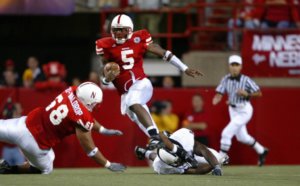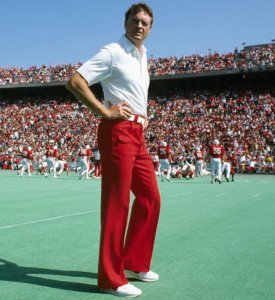College football season is officially upon us. To whet our appetites, a handful of games have already aired including several involving Top 25 teams. If you’re a fan of the game and/or the social culture that surrounds it, this is an exciting time.
Before you don your team’s garb and head to your favorite tailgate spot, watering hole or watch party to root them on to victory, let’s take some time to appreciate everything that goes into putting that product on the field.
Football and marketing have a lot more in common than you might think. Whether you’re a seasoned veteran or a wide-eyed frosh, here are six marketing lessons you can glean from the collegiate gridiron.
1. There is no offseason.
We all get up for those four glorious months through the fall and early winter when the games are played and the fortunes of our team are revealed. The most fervent among us live and die from week to week and when it’s all over, fans can simply pack it up and put it away until next season.
The reality is that the most successful programs never stop working at becoming more successful.

During and immediately after the season, coaches work overtime to recruit the next class of players. Coaches visit prospects in their schools and homes. Recruits visit the campus and attend camps intended to showcase the culture and shiny toys the university has to offer.
For the players already in the program, there’s winter conditioning, spring football, summer conditioning and fall camp before the actual games are played. College football is a full-time, year-round job that requires endless hours of meetings, playbook and film study, physical training and on-field practice.
Successful marketing is no different. We all ramp up at times for larger campaigns throughout the year. Generally speaking, we spend the largest portion of our budget to make the biggest possible splash when it’s buying season or we have something new to sell. Ideally those things converge and we experience our biggest wins.
But even when you’re done with your big push for the year, it’s always onto the next thing. An overhaul of your web presence, new sales collateral, digital campaigns via social, smaller initiatives targeted at specific audience segments, trade show appearances, public relations and virtually anything else you can imagine.
It requires a highly organized, well-orchestrated effort that maximizes the talents and resources you have on hand, however limited. You can never stop generating new ideas and exploring ways to stretch your budget. You have to measure results, identify what worked and what didn’t, tweak the formula until you find the right combination and keep on churning.
If you take time off in between the “busy” seasons, your competitors will be more than happy to pick up the slack.
2. Carve out a unique identity and stick to it.
In order for teams to consistently win at a high level, they must master their offensive and defensive philosophies, know what they’re truly great at and stick to their strengths. If they become too diversified or “multiple” in their schemes, they risk becoming a jack of all trades and master of none.

That approach can work well against most opponents, but quickly falls apart against elite teams with the ability to impose their will. In those cases, you must have something substantive to hang your hat on—an area in which you excel that’s truly part of your DNA. This is the one thing that should enable your team to impose their will.
In marketing, knowing who you truly are (not who you aspire to be) and what you’re great at allows you to carve out a unique identity that’s based on genuine attributes. Your messaging must be consistent both in what you say and how you say it. Once they’re well established, your voice and visual style shouldn’t waver.
3. Punch above your weight class.
In the past, football started later, ended earlier and didn’t generate nearly as much hoopla in the months in between. Even during the season, fewer games were played and only a fraction of them appeared on television.
It was a real advantage for the game’s traditional powerhouses who were among the few to appear on national television a handful of times each season. As in, “Son, why go to Northwestern State A&M when we can prepare you for the next level with better facilities, superior coaching and a national platform to impress NFL scouts?”
When it came to marketing and advertising, the biggest brand names and their deep pockets also controlled the airwaves. Word of mouth was still a factor but it didn’t have the megaphone of social media and online reviews to amplify the message. Communication was essentially one-way and only a select few could afford to play at the highest level.
Billion-dollar brands haven’t gone away and competition on all levels is as fierce as ever, but modern mediums have leveled the playing field somewhat. Upstart companies that know how to maximize the channels available to them can quickly make an impact that far exceeds their resources.
Take your deficits and turn them into virtues. If you’re a small company, extol your personal approach and accessibility relative to the behemoth down the street. If you’re a newcomer, talk about fresh perspectives and your desire to agitate the 800-pound gorilla with smarter products and superior service.
In the modern age of social media, SEO, digital advertising, guerrilla tactics and the ability to generate viral messaging, the opportunity is there for all of us to play the game much larger than our measurables would indicate.
4. Be prepared for anything.
Coaches spend hundreds and even thousands of hours installing and fine-tuning offensive and defensive systems, identifying and developing personnel, training them to execute the schemes as a cohesive unit and formulating gameplans specific to each opponent. All of that happens before they ever take the field.
They must be prepared for anything and everything. And yet, key players still get injured without warning. Opponents show up with unexpected (and sometimes superior) schemes and gameplans. Players fail to execute plays they mastered in practice. Weather intervenes. The ball bounces funny.

As the saying goes, the best-laid plans of mice and men (and marketers) often go awry. The promotional ideas and messaging we put into the world is intended to grab attention in a cluttered marketplace and stand out from the noise. We have to be bold and take chances if we want to be memorable. As with anything subjective, the results and reactions aren’t always what you anticipate.
The key is to expect the unexpected, quickly learn from miscues and be ready to turn adversity into opportunity when you can. If your organization fails to live up to a brand promise or your campaign messaging elicits a negative response, own it with honesty and humility and then move on with resolve to work harder.
5. Don’t be afraid to take risks.
How many times have you seen a team with a big lead start to play it safe only to see the other team come back and at least make things interesting again. Prevent defense prevents winning as they say and momentum can shift in a big hurry once the favorite starts playing on their heels.
One of the best examples of gutsy risk-taking was Tom Osborne’s decision to try a two-point conversion late in the 1983 National Championship game against Miami. Nebraska could have kicked the extra point, tied the game and if they had held on, they would have been awarded the title as the undefeated, higher-ranked team.

The two-point attempt fell short and Nebraska lost the championship, but the decision to go for it was reflective of the “win or lose, but never tie” mentality embodied by coach Osborne and his team. The boldness of that call alone cemented Nebraska’s culture on the biggest stage and attracted fans nationwide.
Savvy marketers and advertisers know that playing it safe is about the worst thing you can do. It’s always better to ruffle feathers while making an impression than do something inoffensive that no one will remember. It doesn’t mean trying to reach the end zone every time you touch the ball, but you should be ready to plant your foot and go when an opening presents itself.
6. Wear your brand everywhere you go.
Modern-day head coaches are considered the CEOs of the programs they lead. They don’t just train their players to carry out the Xs and Os on the field, they serve as ambassadors for their program and university.
This involves rubbing elbows with boosters that fund facilities upgrades and ever-expanding recruiting budgets, fostering goodwill with fans that ultimately vote on your performance with their wallets, managing media relations and generally selling your program to anyone who will listen.
Marketers must also think about their brand in terms of real-time perception. Every interaction that prospects or clients have with your company and its employees will shape their perception of your brand image, including casual interactions outside of business hours.
Don’t just think of marketing in terms of campaigns via paid media channels. Consider every little way you can reinforce your messaging when people do business with you or otherwise interact with your organization. If someone applies to work for you and doesn’t get the job, what will they say to others about their experience?
The point after.
Just like football, marketing is a rough and tumble game. The rules constantly change, our competitors don’t always play fair and we’re bound to take plenty of lumps along the way. What worked yesterday won’t necessarily work today, so we must continue to innovate and can’t ever let complacency take hold. Otherwise, Northwestern State A&M will be waiting in the wings ready to pull off the upset.
Request a free website demo!
